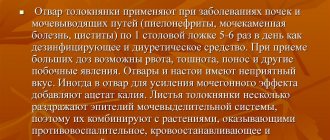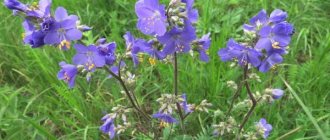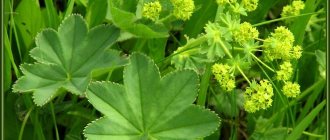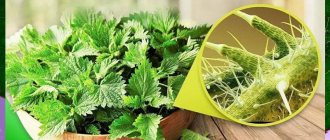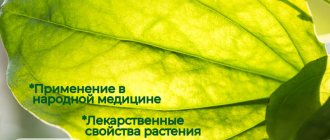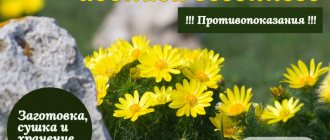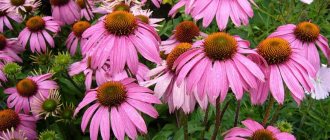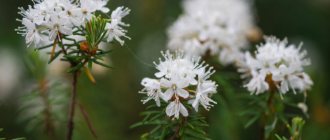Mint is a herbaceous plant belonging to the Lamiaceae family. Currently, there are more than 25 species and 10 subspecies of this crop. The leaves and inflorescences of the herb contain volatile esters, which give the plant a menthol aroma. Along with this, mint contains flavonoids, tannins, vitamins and minerals. Due to its rich ingredient composition, mint is widely used in traditional and folk medicine.
The aromatic herb is used to stimulate the digestive glands, eliminate spasms, reduce nervous excitability, relieve headaches, and suppress putrefactive flora in the intestines. Infusions, decoctions, extracts, and essential oils are made from medicinal raw materials. In addition, mint is used in the perfume, cosmetics, alcoholic beverage and confectionery industries.
Morphological description
The rhizome is horizontal, branched, with fibrous thin roots. The stem is straight, from 30 to 100 cm in height, hollow inside, and has 4 sides. The plant is characterized by a large number of lateral branches and leaves. The leaves are opposite, arranged crosswise, have an oblong-ovate shape and short petioles. The tips of the leaves are pointed, the base is heart-shaped and has a sharp-serrated edge.
The flowers are small in size, light purple in color, collected at the top in half-whorls, from which spike-shaped inflorescences are formed. Flowering occurs in the summer, from June to September. The fruit consists of 4 nuts and is formed quite rarely.
What kind of plant is this
The question of what mint looks like is not so easy to answer, since the abundance of species and hybrids of this popular plant is truly impressive - there are about 300 of them in nature. Of course, there are many common characteristics, but some differences, for example, in the chemical composition or aroma, sometimes make them completely different from each other.
Mint belongs to the Lamiaceae family, which is also represented by the well-known lavender and dead nettle. Almost all types of mint have a distinct aroma because they contain a large amount of menthol, an organic substance that has mild anesthetic, antiseptic and vasodilating properties.
In addition, mint leaves and inflorescences contain:
- essential oil;
- organic acids;
- flavonoids;
- phytoestrogens;
- tannins;
- bitterness;
- vitamins A, C, PP, group B;
- potassium;
- phosphorus;
- calcium;
- magnesium;
- sodium;
- manganese;
- iron;
- zinc;
- copper.
Depending on the species, the leaves are round or elongated, arranged crosswise on a stem reaching a meter in height. Small flowers of light lilac, white, pink or pale purple are collected in inflorescences at the top of the stem. The root is horizontally located and quite branched, with its help the plant actively reproduces.
Procurement and storage of raw materials
The aerial part has medicinal value. For self-harvesting, mint leaves are most suitable, which should be collected in dry weather at the beginning of flowering.
The raw materials are dried in air, in the shade. If leaves are collected, they are dried on clean paper, if branches are collected, they can be dried with awnings. Mint dries well and quickly, after which it is placed for storage in cardboard boxes. The shelf life of dry raw materials is 2 years.
The raw materials should be crushed immediately before preparing the medicine, but not in advance, so as not to lose valuable essential oil.
Methods for harvesting mint
Drying mint
Mint harvesting begins in June, after flowering begins, and continues until the end of July. It is best to collect mint bushes in the morning (after the dew has dried) or in the evening (from sunset to the dew), since high humidity can negatively affect the drying process.
Dirty and damaged leaves should be removed from the total mass, and the collection should be washed and dried thoroughly with a paper towel. Drying itself can be done naturally (in the fresh air) or accelerated (in the oven or microwave).
To dry naturally, the stems are tied into bunches and hung with the leaves down in a dark, dry place with good air circulation. Direct sunlight should be avoided when drying. Processing time is 2 to 3 weeks. As soon as the leaves begin to be easily removed from the stems, drying stops.
Drying in an open oven takes place at a temperature of no more than 75 degrees (at higher temperatures, the leaves lose all their beneficial qualities) for about 15–20 minutes. To prevent the leaves from drying out on the baking sheet, you need to cover it with parchment paper.
Dried mint can be stored for 1–1.5 years. To prevent it from losing its taste, you must use an airtight container made of glass, metal or plastic.
Freezing mint
Freezing mint allows you to preserve its taste and beneficial properties for a long period. For proper freezing, it is necessary to use fresh leaves without damage or stains. The leaves are placed in a bag or cling film, then sent to the freezer.
Mint syrup
Mint syrup is an excellent substitute for fresh leaves when added to tea, coffee and alcoholic beverages, and is also an ingredient in many confectionery products.
To prepare 200 g of syrup you need: 100 g of mint leaves, 250 g of sugar, a pinch of citric acid, 70 g of water.
Coarsely chop the mint, add 125 g of sugar and add citric acid. Leave for 8–10 hours for the leaves to release their juice. Pour 125 g of sugar with water, bring to a boil over low heat and simmer for 4-5 minutes until the sugar is completely dissolved. Pour the mint with the resulting syrup and leave to cool for 5-6 hours, then boil for about 5 minutes, strain through a fine sieve and pour into a pre-sterilized jar, as shown in the video.
Richard “Royal Green” tea, green, 25 bags 96 rub.
Curtis “Cold Tea” tea, green with citrus, 12 pyramids x 3 packs 413 rub.
Curtis “Fresh Mojito” tea, green, flavored, 20 pyramids 92 rub.
Chef Tea “Mango-Passion Fruit”, green with additives 90 rub.
Curtis “Sparkling strawberry” tea, green leaf, with additives, 20 pyramids 92 rub.
Green tea with Morgenthau additives 90 rub.
Konigin Herbarium “Healthy Sleep” tea, green with additives, 20 sachets 98 rub.
Large selection of green tea at TEA.RU
Chemical composition of peppermint
The well-known smell of mint is nothing more than an essential oil, which the plant is very rich in. Oil is a transparent liquid with a greenish or yellowish tint, a pleasant fresh taste and aroma. The content of essential oil varies in different parts of the plant: leaves contain 2.5-4.5% essential oil, inflorescences - 4-6% liquid, and stems - up to 0.3%. The more favorable the growing conditions, the greater the amount of essential oil the plant contains. The composition of the essential oil is represented by menthol, menthol esters (valeric and acetic acids), alpha-pinene, pulegone, cineole, dipentene, beta-phellandrene and other terpenoids.
Fresh leaves also contain tannins and resins, organic acids, betaine, carotene, trace elements, hesperidin, bitterness, vitamins, neutral saponins, glucose and other substances.
So, 100 grams of fresh leaves of the plant contain:
- 70 kilocalories;
- 78.7 gr. water;
- 14.9 gr. carbohydrates;
- 8 gr. fiber;
- 3.8 gr. proteins;
- 0.9 gr. fats;
- 0.2 gr. saturated fatty acids;
- 570 mg potassium;
- 80 mg magnesium;
- 30 mg sodium;
- 75 mg phosphorus;
- 243 mg calcium;
- 5 mg iron;
- 30 mg vit. WITH;
- 1.7 mg vit. AT 3;
- 0.3 mg vit. B2 and B5;
- 0.1 mg vit. B1 and B6.
Composition and characteristics
The herb with a unique fresh aroma has a disinfecting and relaxing effect. This is due to the content of tannins, manganese, copper, magnesium and vitamin A. It is used to increase appetite, relieve stress, get rid of depression, as well as to normalize the gastrointestinal tract and relieve pain from frostbite and wounds. The usefulness of the herb is explained by the presence of valuable components in the composition:
- vitamins of groups D, C, B and A,
- essential oils (esters + menthol),
- a whole complex of minerals,
- phytoncides,
- organic acids (acetic, linoleic, valeric),
- phytosterols;
- carotene,
- betaine.
The essential oils of the product include more than 50% menthol, thanks to which the herb has its unique aroma and taste. The substance has antispasmodic and analgesic properties. Ascorbic acid and carotene help strengthen the immune system, vitamin P relieves swelling, and betaine improves liver function, providing a choleretic effect. The healthy plant has a very low glycemic index of 3.
Medicinal properties of mint
The plant is used for a number of diseases. A huge contribution to the study of the properties of mint was once made by the British, who, through a series of experiments, discovered the effect of menthol on the human body. Upon contact with skin or mucous membranes, menthol causes irritation of cold receptors, stimulates the narrowing of superficially located vessels and the reflex dilation of blood vessels that nourish internal organs. It is this effect and a mild local anesthetic effect that is used in the relief of angina attacks (the well-known drug validol).
Mint preparations have the following therapeutic effects:
- soothing;
- vasodilator;
- sedative;
- painkiller;
- antiemetic;
- antiseptic;
- anti-inflammatory;
- improves digestion and appetite;
- antispasmodic;
- carminative;
- diuretic;
- choleretic;
- anticancer.
The scope of mint is wide - it is used to treat diseases:
- viral and bacterial nature, occurring as acute respiratory infections: tonsillitis, pharyngitis, bronchitis, bronchospasm, rhinitis, as well as tuberculosis;
- cardiovascular system: hypertension, angina pectoris, circulatory failure, coronary vascular spasm. Also used for heart palpitations;
- nervous system: insomnia, depression, nervous agitation, stress, migraines, decreased attention and memory;
- digestive system: nausea, vomiting, spasmodic pain, colic, flatulence, poor appetite, hepatitis, gastritis, incl. caused by H. Pylori, cystitis, cholecystitis, salmonellosis, cholelithiasis, urolithiasis, irritable bowel syndrome, helminthic infestation, oral diseases;
- skin and mucous membranes: itching, rash, including herpetic nature, dermatitis, burns, acne, pimples, dandruff, insect bites, sweating, increased oily skin, enlarged pores and wrinkles;
- female genitalia: heavy menstruation, manifestations of menopause;
- pain syndrome: toothache and headache, spasm of smooth muscles, myalgia, bruises, sprains, neuralgia.
For preventive purposes, the anti-carcinogenic effect of mint is actively used, especially pronounced in the prevention of cancer of the skin, colon, pancreas, liver, lungs, breast and prostate gland.
Plant preparations are used to improve the functioning of the immune system. Mint increases the resistance of body cells to long-term exposure to small doses of radiation, so it can be used in parallel with the course of treatment for cancer, as well as in cases of living in unfavorable radiological conditions.
Application in cosmetology
Mint is widely used in the cosmetology and perfume industries. Based on it, products are produced that have a cooling, aseptic, calming and at the same time tonic effect. The plant extract is also used in the production of cosmetic products designed to eliminate unpleasant odors (antiperspirant deodorants, oral sprays).
The medicinal properties of peppermint allow it to be used to improve the appearance of skin, nails, hair, and to establish physiological processes in them. It is used to produce professional lotions, creams, face masks, balms, scrubs, and peelings. The plant can be used at home to create similar products.
Facial skin care
Cosmetics with peppermint are characterized by the ability to remove accumulated ecotoxins from tissues, normalize the functioning of the sebaceous glands, eliminate itching, irritation, and inflammation. They tone, moisturize the skin of the body and face, saturate it with vitamins, microelements, and improve color. The plant is recommended for the fight against acne and pimples.
Directions for use:
- Lotion for combination, oily skin: 3 tbsp. spoons of dried leaves are poured with 200 ml of hot water. The broth is infused for half an hour and filtered through a piece of gauze. Used daily twice a day.
- Nourishing mask: mix freshly picked plant leaves (12 pieces), 1 yolk and full-fat sour cream (100 g). The composition is applied to the skin for 15 minutes.
Cosmetics with mint increase the protective function of the epidermis and improve the condition of the skin if it is sunburned. They are effective in the presence of bacterial dermatitis, rosacea, acne, eczema, and fungal infections. Prescribed in cases of herpes zoster, dermatosis, scabies, burns.
Hair care
Mint has bactericidal properties, cools and tones the scalp, and reduces sebum production. Helps moisturize and nourish hair, restore its natural structure. Effectively eliminates itching, dandruff, oily shine, accelerates the healing of microcracks. Usage options:
- Add 2 drops of essential peppermint oil to a single serving of shampoo. The product is applied to the hair, foamed, left for 2 minutes and washed off with a large volume of running warm water.
- Leaves (2 tablespoons) are brewed with hot water (400 ml). The liquid is infused for half an hour, cooled and 2 drops of mint ether are added to it. Rinse clean hair with the prepared mixture.
Such products normalize the acid-base balance, restore strands after chemical styling and dyeing, and give them strength and thickness. They accelerate the growth of curls, strengthen weakened, brittle hair, and prevent hair loss. A contraindication to the use of the product is the presence of deep open wounds on the scalp.
Contraindications to the use of mint
- Gastric achlorhydria;
- Increased acidity of gastric juice;
- Individual intolerance to plant drugs;
- Severe allergic reactions, including to food;
- Phlebeurysm;
- Hypotension;
- Infertility, reduced ability to conceive, both in women and men;
- Severe weakness, adynamia, drowsiness;
- Children's age is up to 3 years, and for dosage forms with a high menthol content - up to 6 years.
Contraindications and side effects
It should be remembered that the benefits and harms of mint for men depend on the amount taken. The fear associated with the negative effect of the plant on potency is exaggerated. Mint does contain an analogue of estrogen, however, to get a “loading dose”, you should eat at least 1 kg of fresh raw materials, and this is difficult to do, so decoctions and teas taken in the recommended dose will not harm. But there is obvious harm from consuming the herb for allergy sufferers - a large amount of essential oil can provoke disorders, including anaphylaxis.
The benefits and harms of mint for men whose activities are related to concentration are discussed separately. The components of the plant have a relaxing effect, so drivers and workers who are forced to maintain reaction speed for a long time should drink decoctions and teas with extreme caution.
Contraindication for use:
- Individual intolerance;
- Acute nervous excitability;
- Infertility;
- Reduced blood pressure.
Whether it is worth using grass, whether mint is harmful for men - everything is decided on an individual basis. If in doubt, it is better to consult a doctor. With all this, doctors emphasize: when used correctly, the plant can restore the functionality of erectile function, but if the dosage is exceeded, the drinks reduce the viability of sperm, but this does not affect potency in any way.
Use for women during pregnancy and lactation
If there are no contraindications and the doctor allows the use of mint preparations, they can be used to combat the nausea that accompanies toxicosis. But mint during pregnancy should be taken in very small doses, since pregnant women often develop allergic reactions to various plants.
It is believed that mint in small quantities improves lactation, and in large quantities it suppresses it, so in moderate quantities it can also be used by nursing mothers, again, if the attending physician and pediatrician allow it. You should also ask your doctor how much mint you can drink.
Pregnant and lactating
It is not recommended to take mint during pregnancy. The plant contains phytoestrogens and other substances that can cause uterine tone. In the early stages, this phenomenon leads to miscarriage. In case of stress and severe toxicosis in the second or third trimester, after consultation with the doctor, you are allowed to drink 1 cup of mint tea. This remedy quickly calms, relieves the urge to vomit, and helps eliminate swelling.
When breastfeeding, mint drinks should not be consumed: they harm lactation. However, when the mammary gland hardens, you can make compresses with a paste of fresh mint leaves. The product helps soften the breasts, dilate the ducts, and eliminate pain.
Medicinal forms of mint and their uses
Infusion of mint leaves
Alcohol and water tincture is used:
- To prepare a water infusion, 1 tbsp. dry mint is poured with boiling water (200 ml) and left in a thermos for 60 minutes, filtered. Take a sip 3-4 times a day to treat gastrointestinal diseases, digestive disorders, colds, coughs, and to relieve heart pain. When treating diseases of the nervous system, take 100 ml three times a day so that the last dose is before bedtime. Externally used in cosmetology to improve complexion, eliminate fine wrinkles, increased oily skin and enlarged pores.
- To obtain an alcohol setting, 1 part of the dry raw material is mixed with 5 parts of vodka and kept in the dark for 14 days. Used for rubbing for certain skin diseases and migraines (rubbed on temples). Take orally diluted with water, 10-15 drops twice or thrice a day. – to relieve pain, for women’s problems (heavy menstruation, menopause), for preventive purposes.
Mint decoction
1 tbsp. dry raw materials, pour 500 ml of water and cook over low heat for 15 minutes and infuse for another 15 minutes, filter. Drink 100 ml with the addition of honey (1 tsp) for nausea, rapid heartbeat, and bad breath.
- For dermatoses, add a decoction to the bath, but make it more concentrated (50 grams of herb ~ 10 liters of bath water).
- Mint decoction for hair is used as a final rinse after washing - it gets rid of excess oil, strengthens the hair roots and adds shine to the hair.
Tea with mint
The most popular medicinal form of the plant is mint tea, the benefits and harms of which have long been studied. To prepare tea, take both dried and fresh leaves in a volume of 2 tbsp. and fill them with 1 liter. boiling water in a kettle.
It should be understood that mint tea is medicinal and should not be consumed like regular black or green tea. The optimal dose for adults is 100 ml 2-3 times a day, for a child – 50 ml with the same frequency.
It is used in the treatment of colitis, spasms and pain of the gastrointestinal tract, nausea, flatulence, to improve digestion and appetite, as a choleretic drug. It helps well with colds, neuroses and chronic fatigue. Prescribed for rinsing the mouth, throat and nose. Used for respiratory diseases - bronchitis, pharyngitis, rhinitis for inhalation.
Peppermint oil
It is difficult to obtain this dosage form yourself, so you should buy ready-made oil at the pharmacy. For internal use, 2-4 drops are dripped onto a piece of sugar and dissolved. It has a therapeutic effect for diseases of the heart, lungs, liver and gallbladder, nervous system, headaches, flatulence, and helps to recover after a long illness.
Externally used for spot application on acne, insect bites, temples (for headaches), joints (for joint pain), throat and chest to alleviate colds, muscle projection (for myalgia).
Mint drops
To obtain them, you need to take medical alcohol of 90% strength, mint oil and dry mint leaves. For 1 part of raw material, take 20 parts of alcohol, leave for 1 day, periodically shaking the contents. At the end, add 1 part of mint oil. Take 10 drops 2 times a day with water for digestive disorders such as cramps, nausea, flatulence, diarrhea.
Baths
For a foot bath, pour 50 grams of leaves into 1000 ml of boiling water and leave for 30 minutes under the lid. When warm, pour it into a basin and place your feet there for 15 minutes. Recommended for excessive sweating of feet, at night.
When to collect and how to dry mint
The plant does not require careful care and special growing conditions, so many housewives grow grass in a flower pot. In this case, it is necessary to cut off the leaves during the ripening period several times a month.
Home-grown mint must be properly dried. There are several proven methods:
- Using an oven or dehydrator. The method is effective, but the product loses most of its beneficial properties.
- Hanging herb bunches in a well-ventilated, dark place.
- Dry the washed stems and leaves on a natural cloth away from sunlight.
You can store fresh leaves in the refrigerator by freezing them in ice cubes. At any time, the ice can be thawed and the herb can be added to a cocktail or tea. There is another way to store it - put the plant in a pot or vase with water. The grass will fill the room with a wonderful aroma. However, with this option, mint will not lose its properties and taste only for a week. In addition, it is necessary to change the water.
Pharmaceuticals
- Mint herb – used for preparing teas and infusions;
- Packaged mint tea, indicated for the conditions described above;
- Peppermint oil and menthol. They are sold in the form of independent dosage forms in bottles with a dispenser, and are also included in such drugs as Corvalol, Doctor Mom lozenges, Fitolor, Validol, Zelenin drops, Gevkamen, Menovazin, etc.
- Mint tablets that help with vomiting, nausea, gastrointestinal spasms;
- Dental drops, dental elixir.
In what form is it sold, how to choose
Examples:
- Essential oil. Obtained by distillation of fresh raw materials. It has a menthol aroma with notes of camphor. Used as an antispasmodic, tonic, anthelmintic, expectorant. Effective in aromatherapy. The oil is used in baths and saunas to cleanse the air of infections, give the vapor a pleasant smell, and improve the condition of the skin and lungs. The drug is also drunk for stomach cramps and nausea. Before use, dilute in warm water.
- Mint tablets. They have an antispasmodic and vasodilating effect. Used to prevent vomiting and gastrointestinal pain.
- Tea bags. Made from crushed raw materials. Intended for the preparation of medicinal and preventive drinks to eliminate diseases of the stomach, liver, kidneys, and nervous disorders. In pharmacies you can find products from FitoPharm, PharmaTsvet, Green Side, Aspera, EKOlab, Medipharm, Lekraset. Tea bags with mint can also be found in stores such as Lipton, Hornimans, and Monastic Herbs.
- Dry raw materials in cardboard and transparent packages. Indications for use: diseases of the gastrointestinal tract, hepatitis, cholecystitis, cholelithiasis, cholangitis, nervous disorders. It is also used to prepare diuretic drinks.
- Tincture. Recommended as a sedative, antispasmodic, choleretic, antiemetic, analgesic.
- Mint hydrolate. Used as a tonic, for compresses, and in the preparation of cosmetics.
The plant is included in complex preparations for coughs, sore throats, and nervous disorders, made in accordance with GOST. For example: “Linkas Lor”, throat lozenges, “Persen”, “Valersen+”, “Relaxonaz”, “Valerian Lux”, “Sedalite”.
You can find mint syrups in stores. They belong to the culinary class and are used to prepare refreshing drinks at home and in bars.
Side effects
- Therapy with mint preparations may be accompanied by general lethargy and drowsiness, so such treatment excludes the possibility of driving a car and working with precision mechanisms, which require increased concentration.
- Another unpleasant side effect for men is a decrease in potency. However, such a reaction is rarely observed with long-term treatment in large doses and especially in those who already had problems with potency.
- It is believed that mint reduces the ability to conceive.
- People with hypersensitivity may develop allergic reactions such as rash, dermatitis, and itchy skin.
- Excessive consumption of mint causes heartburn.
Author:
Sabuk Tatyana Leonidovna hygienist, epidemiologist
Classic recipes for tea, decoction, infusion
To prepare medicinal mint drinks, you can use the following instructions:
- Traditional tea. Pour 2 tablespoons of dry leaves or 3 sprigs of fresh shoots into 1 liter of hot water. Let it sit for 30 minutes. We filter. To improve the taste, you can add 1 teaspoon of honey to each cup.
- Moroccan tea. Place 2–3 fresh branches in a container, add 2 teaspoons of ordinary green tea leaves, and pour in 400 ml of hot water. Let it sit for 10 minutes. Filter and add 2 tablespoons of sugar. The drink lifts your spirits and tones you up. There is a second version of tea with anise beans and lime.
- Infusion. Pour 4 tablespoons of dry leaves into 1 liter of hot water. We insist 60 minutes. The difference between tea and infusion is the concentration of nutrients. There are more of them in the latter.
- Decoction. Pour 1 tablespoon of fresh or dry leaves into 250 ml of hot water. Place in a steam bath and leave for 15 minutes. We filter and squeeze out the raw materials. We prepare the required amount of drink once every 2 days.
- Tincture. Grind fresh or dried raw materials and pour into glass containers. Pour in alcohol diluted to 40% or vodka so that the liquid rises 1–1.5 cm above the leaves. Shake. Close the container with a lid. Place in a cool, dark place. Let stand for 14 days, shake periodically.
The video provides a description of other ways to prepare mints.
Brewing while maintaining maximum benefits
To preserve all the benefits of mint, you need to brew the raw materials correctly:
- Use a thermos with a glass flask. The same temperature is maintained in such a container for a long time, which promotes the release of active compounds from the leaves. The container also prevents contact with metal, which causes oxidation of substances.
- Close the lid tightly. If this is not done, some of the essential oils will escape from the drink with water vapor.
- Fill with water heated to 70 degrees. Boiling water stimulates the process of breakdown of complex beneficial compounds.
What does mint go well with?
Brief description of the additives features:
- Melissa. Enhances the sedative properties of the plant, helps eliminate headaches.
- Chamomile. Complements the anti-inflammatory effect of mint and gives regenerating properties to medicinal products.
- Ginger. It has fat burning and tonic properties and stimulates the appetite.
- Raspberry leaves and berries. They enhance the antiviral and immunostimulating effects of mint and help relieve fever.
- Cinnamon. Helps remove bile, activates liver restoration, and partially neutralizes the harmful effects of the herb on male potency.
- Lemon. Complements the invigorating effect of mint and saturates drinks with vitamin C.
- Dandelion root. Accelerates the reduction of blood sugar levels, removes harmful cholesterol.
- Lemon grass. Stimulates blood circulation, improves the antifungal properties of mint.
- Oregano (oregano). Helps relieve symptoms of poisoning and hangover, accelerates the removal of toxins from the body.
- Rose hip. Strengthens the diuretic effect of the herb, relieves fever during colds.
- Motherwort. Increases the calming effect of mint and helps eliminate flatulence.
- Eucalyptus. Activate expectoration. Eucalyptus components help treat pathologies of the respiratory system.
- Liquorice root. Fights nausea and vomiting, non-productive cough.
- Cranberry. Helps eliminate genitourinary infections, stimulates appetite, and facilitates the functioning of the pancreas.
Peppermint tea in medicine
In every pharmacy, among the variety of medicinal herbal preparations, you can see a whole shelf of packages with dried mint leaves for tea. Doctors recommend using mint tea in combination with medications and as an alternative to many drugs. Therapists advise brewing tea for colds and for prevention during the cold season, cardiologists recommend using it together with prescribed medications to combat angina pectoris, tachycardia, and arterial hypertension. Doctors recommend drinking tea for people suffering from myalgia, neuralgia, rheumatism and radiculitis. Tea has a moderate sedative, carminative, analgesic, and antiseptic effect. Doctors in many practices find it beneficial to include the use of peppermint tea in their patients' treatment.
In case of poisoning
Symptoms of poisoning may be somewhat similar to those of a hangover, but it is important to remember that many foods are prohibited for consumption in this condition. Luckily, peppermint tea is not one of them. Collecting mint will help stop vomiting and relieve painful symptoms. It is advised to mix mint, oregano and St. John's wort in equal quantities and pour boiling water over a spoonful of the resulting mixture. Soon the discomfort caused by the poisoning should subside.
For a hangover
After a noisy feast with alcohol, you can feel a terrible malaise the next morning, but if you have mint in your medicine cabinet, you can easily overcome it. To relieve hangover symptoms, such as nausea and headaches, it is recommended to prepare mint tea from leaves, collected yourself or purchased at the pharmacy in the form of filter bags. You need to prepare this tea according to an already known recipe - just pour boiling water over it and let it brew. For greater effect, it is recommended to add honey.
For gastritis
Gastroenterologists recommend mint tea for inflammatory processes associated with gastritis. A drink prepared from dry leaves can relieve pain, bloating and cramps. Fresh mint leaves in tea can activate secretory activity, neutralize nausea and relieve discomfort. The secret of healing tea is that it is an excellent antiseptic and has an effect on the gastric mucosa, while its antispasmodic properties affect the smooth muscles of the stomach. A healthy decoction is prepared from 50 g of fresh or 5 g of dry leaves, pouring boiling water over it and keeping it covered for a quarter of an hour.
For diabetes
Mint leaves used as tea can help people suffering from diabetes. Menthol can lower blood glucose levels, but the main thing is not to overdo it, since mint tea may be poorly compatible with medications prescribed to the patient. To achieve maximum effect, people suffering from this disease are advised to drink up to three cups of tea a day for several weeks, and then take a short break.
For pancreatitis
Thanks to the biologically active components contained in mint, tea can be a real salvation in the fight against pancreatitis. It can significantly increase the effect of taking non-natural medications. In the chronic course of the disease, tea from a fragrant plant will help reduce exacerbations and smooth out the adverse effects of medications. To prepare healthy tea, 10 g of dried leaves must be poured with boiling water, steeped and used without sugar, half a glass 3 times a day.
What does it treat?
Due to its properties and rich composition, mint is used in the treatment of the following pathological processes:
- cardiovascular diseases;
- liver and kidney diseases (cholecystitis, hepatitis, cholelithiasis, etc.);
- digestive disorders, pathologies of the gastrointestinal tract, stomach pain;
- colds, cough;
- nausea, belching;
- increased gas formation;
- asthmatic attacks (in the absence of contraindications);
- sleep disturbances, increased anxiety, stress;
- respiratory tract diseases (pneumonia, bronchitis, etc.);
- inflammation, acne and other skin problems;
- increased body weight;
- menopause, painful menstruation;
- gynecological pathologies in women;
- acute headache or toothache.
Mint: benefits and harms for various diseases
Fresh mint provides benefits for common health problems without harming the body. The herb is used in the form of decoctions, infusions and tinctures, inhalations with ether, and eaten fresh. Medicines and dietary supplements are made from plant extracts.
Does mint help with cough?
When coughing, remedies containing the plant are beneficial due to their properties:
- soften mucous membranes;
- kill pathogenic microorganisms;
- increase immunity.
Coughs are treated with teas, decoctions and tinctures made from this herb. They gargle with tinctures, decoctions and teas are taken orally. Inhalation with ether has the same properties as oral administration.
Does mint increase or decrease blood pressure?
Plant extracts lower blood pressure; people with hypotension should limit the use of herbal products. To prevent the plant from causing harm to health, limit the consumption of tea to once a day and refrain from infusions, baths, inhalations, and compresses.
For headaches caused by low blood pressure, the extract of this herb will aggravate the situation, cause nausea, vomiting, and the beneficial properties will turn harmful.
Is it okay to have mint if you have diabetes?
For diabetic patients, plant extracts are beneficial; the herb lowers sugar levels. But for men, people with low blood pressure or varicose veins, even with diabetes, mint is contraindicated in large quantities.
Mint for pancreatitis
During this illness, the herb is useful for treatment. The properties of stimulating bile secretion, relieving smooth muscle spasms, and stimulating regeneration are useful for pancreatitis.
Important! When the disease is severe, herbal medicine should be resorted to at the end, after conventional therapy. Herbs are more useful in prevention than in the treatment of advanced disease.
Is mint good for gastritis?
During gastritis, the herb is used for medicinal purposes with caution. But if you take precautions, in case of illness, products with mint will not cause harm to your health.
- Herbal decoctions and infusions soothe the mucous membranes and relieve pain.
- The plant relieves spasms.
- The ester contained in the herb reduces stomach acidity.
- Extracts regulate appetite.
Self-medication for gastritis is contraindicated. First, they are treated by a gastroenterologist, then, after consultation, they independently maintain their health with herbs.
Mint in cooking
The leaves of the plant are used as a spice, added to salads, drinks, and made into jam, for the sake of taste, not beneficial properties.
Those suffering from migraines, neuralgia or those with colds will notice the benefits of mint herb jam. It will lower the temperature, have an expectorant effect, and reduce pain of various origins.
The benefits of mint in salad are not expressed; the herb is added in the same way as dill and parsley. Regular consumption of food will have the same effect as regular drinking of tea, it will calm you down and improve your immune system.
For heartburn, mint is mixed with kefir or excluded. The mixture is drunk once a day. It is useful to add a banana to the mixture.
Recommended reading: Benefits of bananas
Fresh mint herb, when taken as food, is beneficial when the plant is eaten in moderation. Excessive consumption will cause harm and the negative properties of the plant will appear.
What are the benefits of mint?
The beneficial properties of the plant are suitable for the treatment of nervous diseases and stomach disorders. For the beauty of skin and hair, treatment of eczema, fungus, toothache, herbal extracts are used in traditional and folk medicine.
The benefits and effects of mint on the woman’s body
For women, the medicinal properties of mint herb are greater than the harmful ones. You just need to follow the recommendations. Mint is beneficial for the face, for colds, and diseases of the female reproductive system. It is prescribed for:
- painful menstruation, due to its analgesic properties;
- premenstrual syndrome, migraines and muscle pain;
- nervous breakdowns and depression.
In addition, mint is good for the stomach; its properties are to cure digestive disorders and alleviate poisoning, eliminating vomiting and nausea.
The benefits and effects of mint on men
The effect of mint on men is ambiguous. The herb treats them the same way as women. But the substances contained in the plant are harmful to men. Mint negatively affects potency in men and hormonal levels.
The total dose of the plant is calculated by a specialist, but tea once a week will not cause any harm. For older males, the herb will be useful as a tonic and at the same time a sedative.
We recommend reading: Tea with thyme: beneficial properties and contraindications
The harmful properties of mint herb for men outweigh the beneficial ones, so treatment with it is not recommended.

